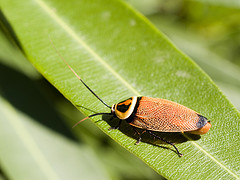Insect cyborgs a possibility with recent biofuel breakthrough


Scientists at Case Western University have developed a biofuel cell that uses a cockroach's body chemistry to harvest energy, making cy-bugs a real possibility. In the past, scientists developing these insect cyborgs have drawn heat or light energy from wing movement, but this cell relies on the insect's normal feeding. The power created could be used for sensors, recording devices or could allow humans to control the bug. Such technology would allow the insects to be used as first responders to a situation, which could prevent human lives from being put in danger.
The implantable fuel cell uses enzymes to convert energy stored as sugars in the bugs' stomachs into electricity.One enzyme breaks trehalose--a sugar that cockroaches produce from their food--into two simpler sugars, which are subsequently oxidized, releasing electrons.
Researchers are hopeful about this technology because they found that it did not cause long term harm to the insects. They're now working to make the fuel cell small enough to not interfere with the insects normal motions. Daniel Scherson, chemistry professor at Case Western Reserve and senior author of the paper, says it's much easier to use insects than to try and create something out of scratch that works as such. If he can perfect this science, he says that, "an insect equipped with a sensor could measure the amount of noxious gas in a room, broadcast the finding, shut down and recharge for an hour, then take a new measurement and broadcast again."
[via gizmag]
Related on SmartPlanet:
- Fishing technology reduces seabird deaths
- Homeland Security technology could predict and detect crimes
This post was originally published on Smartplanet.com